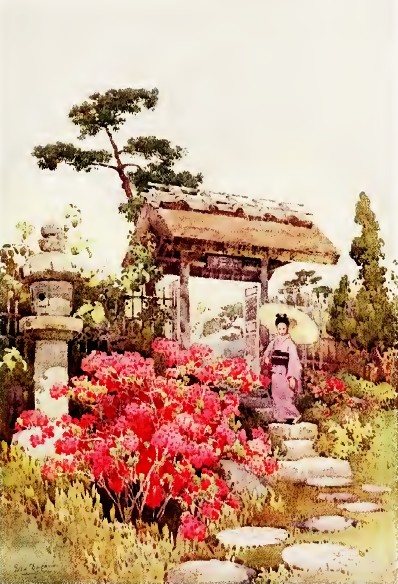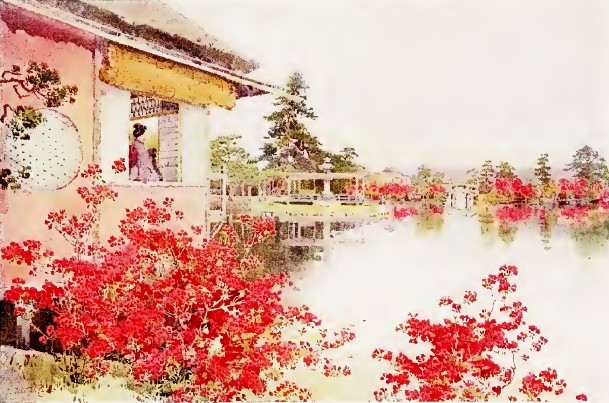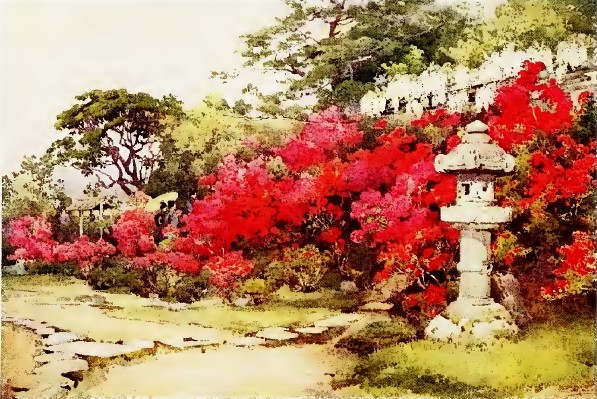| Web
and Book design,
Copyright, Kellscraft Studio 1999-2013 (Return to Web Text-ures) |
 (HOME)
|
| CHAPTER
XI AZALEAS EARLY in May the brilliant-coloured azaleas seem determined, by the splendour of their hues, to try and outshine their graceful, tender-coloured predecessors the plum, peach, and cherry. Surely no other plants ever equalled their display of colours — every shade — pure white, cream, salmon, pink, scarlet, orange, and purple; but even all this feast of colour will not make up for the delicate colour of the blossoming trees. There are so many different varieties of azalea, so many different ways of planting them, and even such a variety in their natural growth, that it is hard to say in which surroundings they appealed to me most. The most celebrated place for "viewing azalea blossoms" — Satsuki no hana — in all Japan is in the district of Shinjuku, a suburb of Tokyo, where the show gardens, known as the florists' gardens of Okubo-mura, present a wealth of colour which I feel powerless to describe. These gardens, or rather azalea plantations, as no other plants are grown, are of very ancient date, and were frequented by the Tokugawa Regents, with whom they were as popular as they are with the sight-seer of to-day. A few sen will suffice to obtain permission to enter a never-ending succession of these little gardens, and so dazzled was I by their splendour that I do not remember that any one seemed more beautiful than another. Imagine these great bushes of immense size and great age simply smothered by their blossoms. Not a leaf was to be seen. My eyes ached at last, and I longed for the repose of a stretch of green. In and out among great banks of the scarlet and crimson Kaba-renge, the variety which flowers before the leaves appear, — on past beds of Azalea indica with its large double and semi-double blooms of every shade, the paths will lead us, as if through a maze; and surely this mass of colour helps to bewilder one. I was assured one venerable old bush, the thickness of whose stem testified to its great age, bore each year eight thousand blooms; so closely packed did the blossoms appear to be, that it would have been no surprise to me had I been told they numbered eight million instead of thousands. The whole district was thronged with holiday-makers visiting the little gardens in one never-ending stream. But one thing differed here from all the other floral feasts I had ever seen in Japan: there were few, if any, little tea-houses set up in the gardens for the entertainment of the guests, who generally sit sipping tea, or some more potent beverage, and gaze upon the especial flower they have perhaps tramped many weary miles to see. Here there was no tea-drinking, they all retreated to the neighbouring restaurants; and why? The reason was not far to seek: no human eyes could sit and gaze at that mass of colour for more than a few consecutive moments; one would leave the garden blinded. The whole air was sweet with their delicious scent; the bees were busy collecting honey, especially from the hearts of the sinensis blooms, which seemed the sweetest-smelling variety. No visitor to Japan should miss spending a few hours at Okubo, for surely in no other place in the whole world can such a wealth of colour be seen. The soil near Tokyo must be especially suited to azaleas, as there are many other gardens and parks which in this flower month will be gay with their blossoms. I have mentioned Okubo first, because it is the most celebrated place for azaleas, here every variety and colour are collected in one dense mass; but there were many other places where the blossoms gave me more true pleasure, and where I spent many hours enjoying the scene.  Azaleas At Nagaoka, in the neighbourhood of Kyoto, many a day have I spent, and I know of no place where one can sit more comfortably and peacefully lost in admiration and contemplation. Nagaoka has a large sheet of water, apparently artificial, but beautified by the great bushes of scarlet azalea along the shore, and the great splashes of colour in the water cast by their reflection. Here they are all one variety, with true fiery scarlet blossoms, and as I sat in one of the little thatched houses built out on piles in the water, great bushes were crowding round me; it seemed as though they had even cast their rosy hue upon the houses, as are not all their walls pink, as if they too reflected the colour of the blossoms? I felt I should like to sleep among the azaleas and see them in the early dawn, and watch the mist clear off the water when the sun's first rays would light up their dazzling splendour. But that could not be. Nagaoka, after all, is only a restaurant, though each party of guests is entertained in a separate little house. They are frail structures these little houses, with only their paper shoji to protect one from the chilliness of the night, and remember, summer is not yet here; all through the month of May there will be a freshness in the air to remind you that spring is not yet gone. So to Kyoto we must return; but there was plenty of consolation to be found there. The gardens of the old Awata Palace were a blaze of colour, the azaleas lighting up this beautiful old landscape garden, which at other seasons of the year is apt to look grey and cold and uncared for. The garden here is like two separate gardens; the first part, complete in itself, is the work of the great Kobori Enshu, and the second part, where the azaleas are the glory of the garden, is the work of Soami. Standing between the two is a grand old lantern, whose history is listened to with rapt attention by the little knots of sight-seers who are led by the old priest round the garden and up through the bank of azaleas to look over the great town below, with Hiesan rising in the distance.
 Azaleas, Nagaoka Many a little temple garden is quite transformed when the azalea bushes are in flower, their little miniature mountain sides are gay with the blossoms; though often the better the gardens are cared for, the fewer the blossoms, as, in order to keep the bushes in their regular and prescribed shapes, the flowers have to be sacrificed. The little garden of Chishaku-in I can recall, as having the brilliant-coloured bushes in pleasing contrast to the subdued tones of the clipped box and juniper-trees, and the greyness of the lichen-covered lanterns and mossy stones. No doubt there were many such little gardens and also private gardens, but the flower month is too short, and one can only visit the most favoured places or where chance happens to lead one's steps. For those who prefer to enjoy the azaleas in their wilder state, there are many places where they can wander undisturbed and inhale their scent which comes wafted on the breeze. I am thinking now of Kasuga Park at Nara, where great stretches of Azalea sinensis form a brilliant foreground for the wistaria-laden trees. Nature seems to have arranged a veritable picture, almost too beautiful to be real. These gorgeous blossoms shade from delicate yellows and pale pink, through to the brightest orange and flame colour, growing as the woodland scrub. They are not more than a few feet in height, possibly their growth has been stunted by the deer; but they form in places a real carpet or clothe the banks of the little streams, their colour vying with the splendour of the great temple beyond. I had heard so much of the beauty of the cherry blossom and wistaria and the glory of the maples, and their fame is amply justified; but no one had told me of the beauty of the azaleas, and never had I realised how essentially they belong to Japan. Throughout the length and breadth of the land they seem to grow, and there appeared to be few places where one variety or another had not found a home. Their pale purple blossoms were hanging from the cliffs among the white-flowered andromeda bushes late in April, when I paid a flying visit to Miyajima, and a few days later I found them again on the banks of the canal on my way from Otsu. In the country round Hikone the more brilliant-coloured forms had found a home, and under the old pine-trees, broken here and there by a rocky projection, or even a few grey tombstones of some long-forgotten graveyard, the banks were covered with an undergrowth of azaleas. Farther north the railway leading to Aomori will wind its way through country which at all seasons of the year is beautiful, but how far more beautiful when the salmon-pink low-growing azalea forms an undergrowth to the pine woods; wherever the trees have been thinned the rocky ravines are all lighted up with their colour. The azaleas at Nikko and Chuzenji have been described elsewhere, and I feel as if all the country during those short weeks will "always be seen in my mind through a rosy hue of azalea blossoms."  Azaleas, Awata |